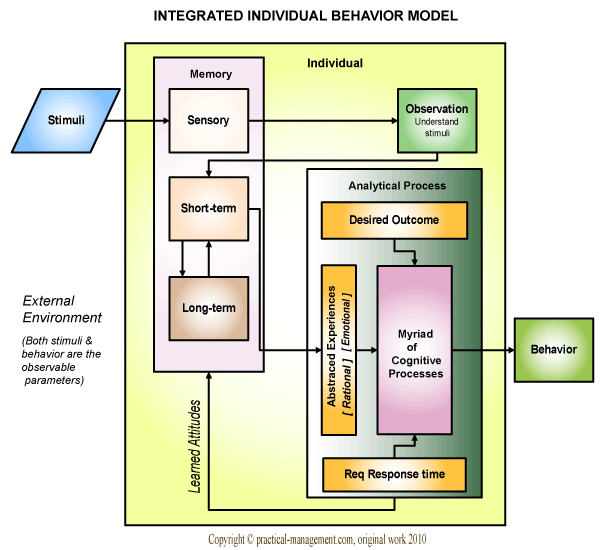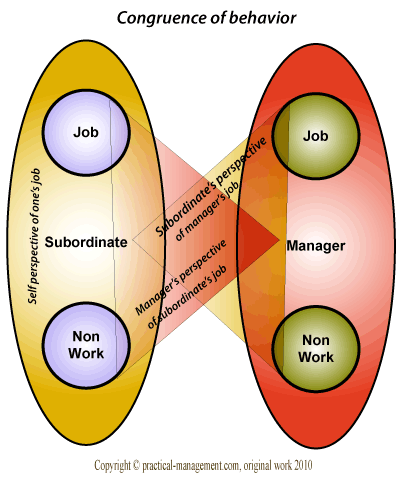Individual behavior in organization
Human behavior is complex and every individual is different from another, the challenge of an effective organization is in successfully matching the task, the manager and the subordinate. Under ideal situation, a manager would first analyze the task, then determine the required skills and assemble a team that complement each other skills; thereby creating an enriching & conflict free team. In reality, a manager has to use the existing resources for a given task, and must have the ability to understand the differences in individual behaviors and use them appropriately to increase the synergy.
In order to understand individual behavior and personalities, it is important to understand the basics of human cognition.
Integrated human behavior model
I have formulated an abstract model of human behavior which explains the process that produces the individual differences. Cognition is the thought process in humans that describes how the information we constantly acquire is transformed, stored and used as knowledge in future decision making. It includes a wide range of mental processes like visual imagery, language, problem solving, decision making etc. The brain receives the stimuli from the external environment through the sense, which is immediately registered in our sensory memory, which is large but keeps the information for few seconds only. The observation process tries to match the information in the sensory memory with the previous knowledge and creates a perception of the stimuli, thereby abstracting useful information from the sensory memory. This abstracted information then passes to the short-term memory or the working memory, which also caches the related knowledge from the long-term memory. The short-term memory has slightly longer latency than the sensory memory, it is needed only till the reaction of the stimuli. The long term memory has enormous capacity and is the primary knowledge base. 
The stimuli demands some action (even the decision to ignore the stimuli is an action), the perceived stimuli combined with a set of related and abstracted experiences forms the initial input to the mind’s analytical process. This input is also influenced by the emotional and rational factors which in turn depend upon individual’s values and beliefs. The other two important parameters are the desired outcome and the required response time to the stimuli. At the center of the analytical mind is a myriad of cognitive processes that operate sequentially or in parallel, in complex permutations in order to satisfy these primary constraints. The consequence of this entire cognitive activity is a response to the environmental stimuli, which is the observed as the behavior of the individual. Person’s thought process is an internal activity while the behavior can be observed. Finally, the resulting behavior is feed backed into the memory; it modifies the existing perceptual knowledge, seeds a new one or the stimuli and its response is simply ignored
Dimensions of cognitive psychology
The cognition can be characterized by considering the process itself and its robustness. At a higher level of abstraction, the thinking can be characterized as rational or emotional, while its robustness is determined by it stability.
Rational Vs Emotional Thinking
Rational thinking is a response based on process of logical reasoning; it involves some form of mathematical or statistical knowledge where the process has implicit proof of its validity. Attribution is one of the rational processes that involve determining the reason or cause of an observed behavior.
Emotional thinking is a response based on how a person feels about the object in question. Neurologically, emotions follow a short cut pathway to limbic response, bypassing the other cognitive thought processes. It can be considered as most primitive response when dealing with incomplete and uncertain sensory data. However, emotions have considerable influence on decision making and other cognitive processes even with existence of alternate rational reasons. Emotions do bootstrap into prior emotional responses and it depends upon a person’s belief and values.
Stable Vs Evolving Experiences
Every stimuli creates a response which is stored in the long-term memory, repetition of the same stimuli over a period of time, hard wires the response. These patterns of stimuli and response form a stable section of our cognitive processes, thus as the person ages, more and more responses get hard-wired.
On the other hand, stimuli that have little or no previously recorded responses are in the evolutionary stage, the response might change depending upon the cumulative degree of success of the previous responses.
Congruence between manager’s and individual’s behavior
Most of the text and research emphasizes the importance of individual behavior and how managers should use this knowledge for better task- to-employee matching, what they ignore is the importance of organization as a system. In the organizational social system, the relationship between manager and the employees is not unidirectional but bidirectional. While the manager tries to assess the behavior of the subordinate, the subordinate also makes a continuous effort to evaluate the manager’s perspective and adapt to it. If this bi-directional process is successful, it would create a behavioral congruence between manager and subordinate and would be a positive outcome. Otherwise it would lead to dissatisfaction and frustration for both of them and would eventually lead to end of their relationship through job termination.
The subordinate will have a perception of his own job and non-work responsibilities and an expectation of how his manager would perceive the same. He will also have a selective and biased perception of his manager’s job and that would in turn influence his expectations and behavior.
Due to identification of this bi-directional relationship, the following discussion is adapted to reflect this concern.
Factors Influencing Individual Behavior
Abilities
Abilities of a person are the natural or learnt traits. Abilities can be classified into mental and physical abilities and different task requires different level of the two. Mental abilities represent the intelligence, person’s deductive reasoning, and memory, analytical and verbal comprehension. Physical abilities include muscular strength, stamina, body coordination and motor skills. An individual’s self awareness of his own abilities determines how he feels about the task, while the manager’s perception of his abilities determines the kind of task he assigns to the individual.
Gender
Although, research concludes that men and women are equal in their mental abilities and job performance, society does emphasize differences. However, absenteeism is one area where differences are found and can be attributed to being primary caregiver to children. However, this creates a difference in self perception of one’s abilities, personal values and social behavior. Similarly, a manager’s personal values might influence how he considers gender as factor in his task assignment and evaluation.
Race
Race and culture exert significant influence when both workplace and society have considerable diversity. Stereotyping and attributing behavior based on race and culture are common mistakes that influence individual behavior. It is important for both management and the staff of diverse workforce to learn about different cultures, their values, common artifacts and communication protocols. This would create a more comfortable corporate culture and would subdue behaviors that might be perceived as insensitive and offensive.
Perception
Perception is the basic cognitive process that transforms sensory stimuli into meaningful information. Most real life problems are multidimensional and the rational approach is often entwined with the gut feeling, resulting in individual perception. This quells the famous notion that reality is objective and thus everyone must perceive it the same way. Both managers and subordinates must recognize that perceptual differences exist and often are the reason for mutual dissatisfaction.
- Stereotyping: It is categorization of individuals on basis of single attribute, it ends up creating a generalized and simplified belief that do not take into account other significant characteristics. Age, race and sex are the three most common basis of stereotyping; not only they are unethical but can cost missing resources. In general, stereotyping leads to decisions that are based on inaccurate data that can result in unfair performance evaluations, job design or promotion.
- Selective Perception: It is the process of selecting only the information that supports our pre-existing belief system, thereby eliminating the discomforting information. Selective perception acts like a catalyst to stereotyping because people tend to notice things that fit their existing notion and not notice things that don’t.
Both stereotyping and selective perception can be beneficial only by chance since they are based on partial information. The specific situations in which they can be positively exploited cannot be used as reliable methods.
Attribution
Attribution is the process of observing behavior and then determining its cause based on individual’s personality or situation. Attribution based on personality is due to internal causes and is termed as dispositional attribution. It includes personality traits like shyness, arrogance, intelligence, etc. Attribution based on external influences and situations that are outside the control of individual are termed as situational attribution. The basic attribution framework uses three criteria mentioned below.
- Consensus: It is the extent to which other people in the same situation might respond similarly. When behavior is attributed to consensus, the individual is not rewarded or penalized due his personality.
- Distinctiveness: It is the extent to which the individual’s behavior can be attributed to situations or to his personality. If the person behaves the same way in seemingly different situations, then his behavior will be attributed to his personality.
- Consistency: It is the measure of the frequency of the observed behavior, how often does the behavior occurs? High consistency is linked to dispositional attribution while low consistency is linked to situational attribution.
Attitude
An attitude is the abstract learnt response of an individual’s entire cognitive process over a period of time. It is experienced as a quick response to a familiar situation without any deep reasoning; it forms the basis of biases and attribution errors. As an example, an individual who has worked in various organizations might develop an attitude of indifference towards organizational citizenship.
Personality
Personality is the relatively stable set of psychological attributes that distinguishes one individual from another. The `integrated individual behavior model’ proposed above, is a framework to understand the process by which the personality develops over a period of time.
